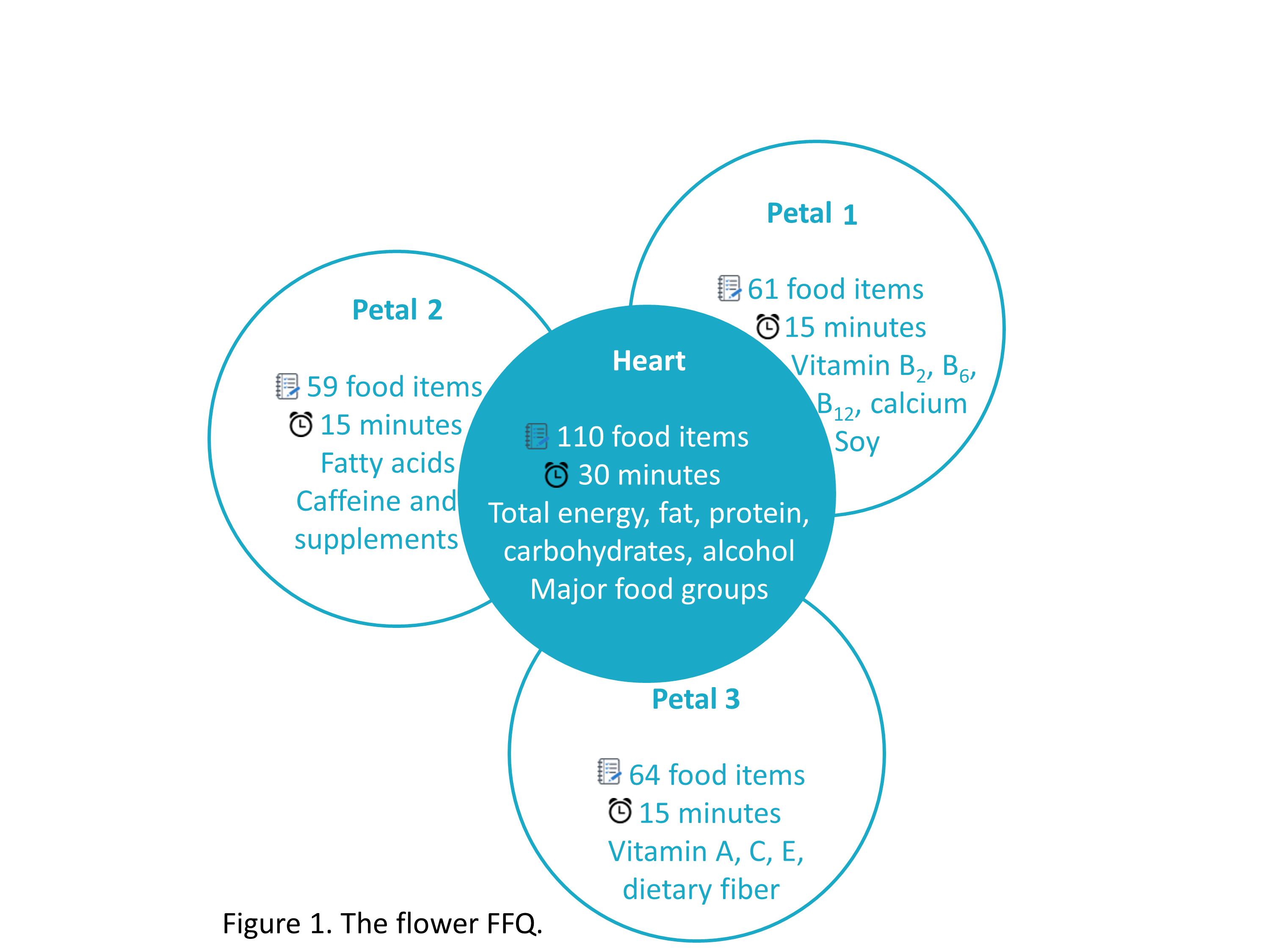This is an old revision of the document!
Table of Contents
Flower FFQ
Dietary intake of Lifelines participants aged 13 years and older was assessed with a food frequency questionnaire (FFQ) developed for Lifelines by the department of Human Nutrition and Health at WUR (section: nutrition).
Children between 8-12 years old filled in a Child FFQ developed by TNO.
| Age: | 0-1 | 4-7 | 8-12 | 13-17 | 18+ |
|---|---|---|---|---|---|
| Flower FFQ | x | x | |||
| TNO FFQ | x | ||||
| General diet | x | x | x | ||
| Infant diet | x |
Background
Dietary intake of adolescent and adult Lifelines participants was assessed with a food frequency questionnaire (FFQ) that was specifically developed for Lifelines to assess dietary risk factors for a considerable number of diseases.
Since this resulted in a long and time-consuming questionnaire, the questionnaire was divided into four parts and called the Flower Food Frequency Questionnaire.
For more information about the rationale for and validation of the flower FFQ see Brouwer-Brolsma et al. (2017) and Brouwer-Brolsma et al. (2021).
The questionnaire consists of one basic questionnaire, assessed at baseline: the heart of the flower. It covers energy and macronutrient intake and takes ~30 minutes to complete. The raw data from the heart FFQ were used to calculate macronutrient sum scores.
The other three shorter questionnaires, the petals, were only used in adults and cover the (micro)nutrients (See Figure 1):
- FFQ1 (Petal 1) consists of 61 food items and is used to estimate the intake of vitamin B2, B6, B11, 12, calcium and soy.
- FFQ2 (Petal 2) contains 59 food items and is used to estimate the intake of different types of fatty acids and caffeine
- FFQ3 (Petal 3) consists of 64 food items and is used to estimate the intake of vitamin A, C, E, and dietary fiber.
The Flower FFQ covers ≥96% of the absolute nutriënt intake and ≥93% of the between-person variability of each nutriënt as assessed in the Dutch National Food Consumption Survey from 1998. For each item participants indicated the frequency of consumption for the past month, this ranged from 'never' to '6-7 days per week'. Portion sizes were estimated using natural portions and commonly used household measures. Average daily nutriënt intakes were calculated by multiplying consumption frequency with portion size and nutriënt content per gram as indicated in the Dutch food composition table from 2006.
NB: The three FFQ petals were randomly distributed to adult participants during the follow-up questionnaires 1B, 1C and 2A Questionnaire 1, so that each participant received the petals in one of six possible orders ([1-2-3], [1-3-2], [2-1-3], [2-3-1], [3-1-2], or [3-2-1]).
Papers using Lifelines FFQ data
- Møller, G. et al. (2017). A Protein Diet Score, including plant and animal protein, investigating the association with HbA1c and eGFR-The PREVIEW Project. Nutrients 9(7): 763.
- Dekker, LH et al. (2017). A spatial analysis of dietary patterns in a large representative population in the north of The Netherlands - the Lifelines cohort study. The International Journal of Behavioral Nutrition and Physical Activity 14(1): 166
- Alexandrov, NV et al. (2018). Dietary Protein Sources and Muscle Mass over the Life Course: The Lifelines Cohort Study. Nutrients 10(10): 1471
- Slagter, SN et al. (2018). Dietary patterns and physical activity in the metabolically (un)healthy obese: the Dutch Lifelines cohort study. Nutrition Journal 17(1): 18
- Vinke, PC et al. (2018). Development of the food-based Lifelines Diet Score (LLDS) and its application in 129,369 Lifelines participants. European Journal of Clinical Nutrition 72(8): 1111-1119
- Dekker, LH et al. (2019). The association of multimorbidity within cardio-metabolic disease domains with dietary patterns: A cross-sectional study in 129 369 men and women from the Lifelines cohort. Plos ONE 14(8): e0220368
- Brouwer-Brolsma, EM (2018). Dairy shows different associations with abdominal and BMI-defined overweight: Cross-sectional analyses exploring a variety of dairy products. Nutrition, metabolism, and cardiovascular diseases / NMCD 28(5): 451-460
- Brouwer-Brolsma, EM (2018). Dairy product consumption is associated with pre-diabetes and newly diagnosed type 2 diabetes in the Lifelines Cohort Study. The British Journal of Nutrition 119(4): 442-455

